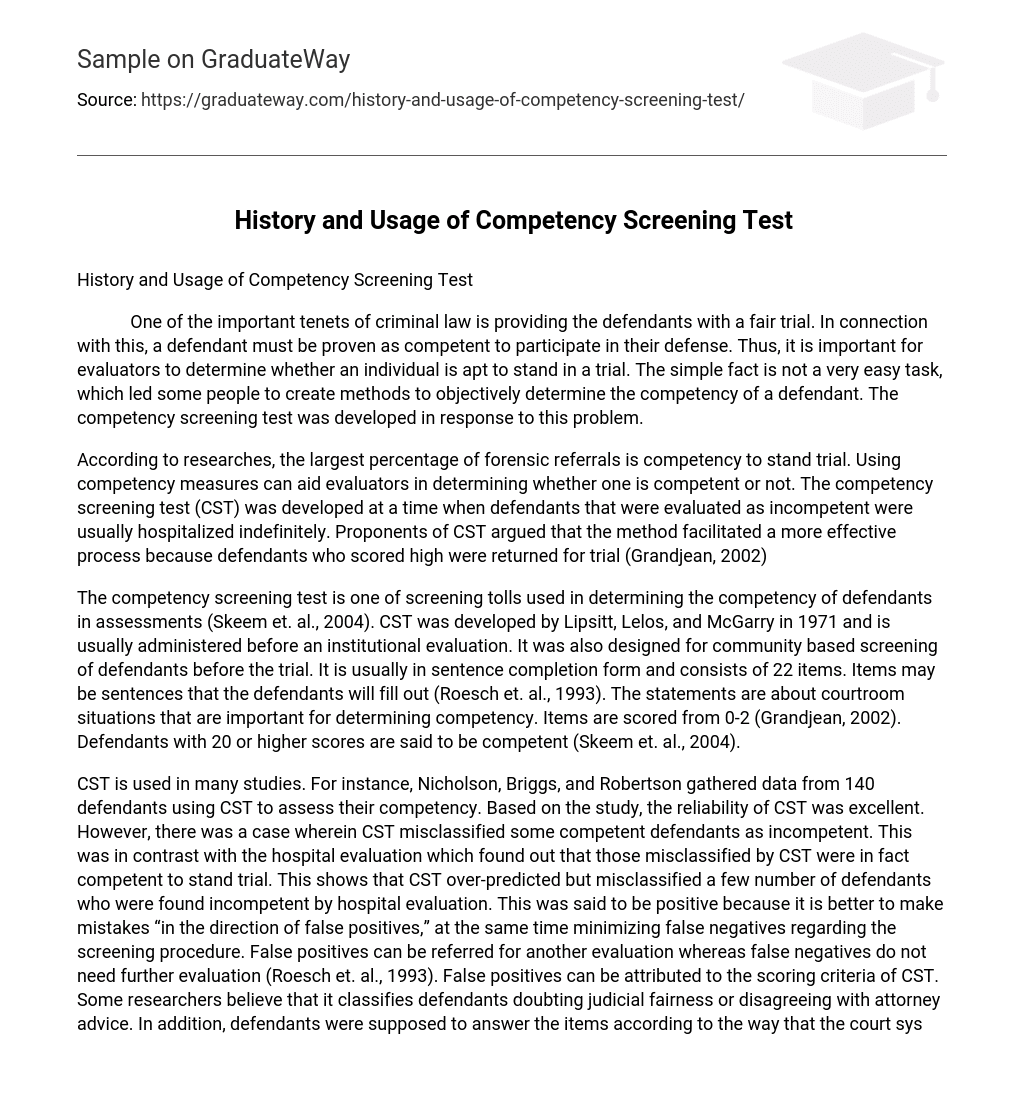History and Usage of Competency Screening Test
One of the important tenets of criminal law is providing the defendants with a fair trial. In connection with this, a defendant must be proven as competent to participate in their defense. Thus, it is important for evaluators to determine whether an individual is apt to stand in a trial. The simple fact is not a very easy task, which led some people to create methods to objectively determine the competency of a defendant. The competency screening test was developed in response to this problem.
According to researches, the largest percentage of forensic referrals is competency to stand trial. Using competency measures can aid evaluators in determining whether one is competent or not. The competency screening test (CST) was developed at a time when defendants that were evaluated as incompetent were usually hospitalized indefinitely. Proponents of CST argued that the method facilitated a more effective process because defendants who scored high were returned for trial (Grandjean, 2002)
The competency screening test is one of screening tolls used in determining the competency of defendants in assessments (Skeem et. al., 2004). CST was developed by Lipsitt, Lelos, and McGarry in 1971 and is usually administered before an institutional evaluation. It was also designed for community based screening of defendants before the trial. It is usually in sentence completion form and consists of 22 items. Items may be sentences that the defendants will fill out (Roesch et. al., 1993). The statements are about courtroom situations that are important for determining competency. Items are scored from 0-2 (Grandjean, 2002). Defendants with 20 or higher scores are said to be competent (Skeem et. al., 2004).
CST is used in many studies. For instance, Nicholson, Briggs, and Robertson gathered data from 140 defendants using CST to assess their competency. Based on the study, the reliability of CST was excellent. However, there was a case wherein CST misclassified some competent defendants as incompetent. This was in contrast with the hospital evaluation which found out that those misclassified by CST were in fact competent to stand trial. This shows that CST over-predicted but misclassified a few number of defendants who were found incompetent by hospital evaluation. This was said to be positive because it is better to make mistakes “in the direction of false positives,” at the same time minimizing false negatives regarding the screening procedure. False positives can be referred for another evaluation whereas false negatives do not need further evaluation (Roesch et. al., 1993). False positives can be attributed to the scoring criteria of CST. Some researchers believe that it classifies defendants doubting judicial fairness or disagreeing with attorney advice. In addition, defendants were supposed to answer the items according to the way that the court system should be (Skeem et. al., 2004).
Nicholson, Briggs, and Robertson found out that CST “taps an intellectual component of the competency construct.” More studies analyzing CST discovered that its factor structure was not clear. In particular, researchers were not able to construe factors that their study obtained. Moreover, CST required that defendants, whose competency was questioned, have writing and reading abilities. This was inappropriate for some, as shown in a study by Chellsen in 1986, involving mildly retarded offenders. The results showed that there were a high number of false negatives. Also, defendants have difficulty answering the test (Roesch et. al., 1993). Because of these issues, it helps that CST is viewed as a method to identify areas that need to be further assessed for full evaluation. Considering the aforementioned issues, CST can generate accurate results if used with other competency tools (Skeem et. al., 2004).
The Competency Screening Test was developed in order to evaluate the competency of defendants to stand trial. It involves answering a set of questions, wherein the person being tested must be able to achieve a certain score in order to be classified as competent. Over time, studies which used CST have faced some challenges with regards to the method. One is that some competent defendants were misclassified as incompetent. Also, some researchers believe that CST’s scoring criteria may discriminate a defendant.
References
Grandjean, N.R. (2002). Competency to stand trial: A systematic evaluation and validation of the GCCT, MACCAT-CA, and ECST as competency measures. University of North Texas. Retrieved February 11, 2009, from http://digital.library.unt.edu/permalink/meta-dc-3145:1
Roesch, R., Ogloff, J.R.P., & Golding, S.L. (1993). Competency to stand trial: Legal and clinical issues. Applied and Preventive Psychology, 2, 43-51.
Skeem, J., Golding, S.L., and Emke-Francis, P. (2004). Assessing adjudicative competency: Using legal and empirical principles to inform practice. In Donohue, W.T. & Levensky, E.R. (Eds.). Forensic psychology: A handbook for mental health and legal professionals. Pp. 175-211. New York: Academic Press.





